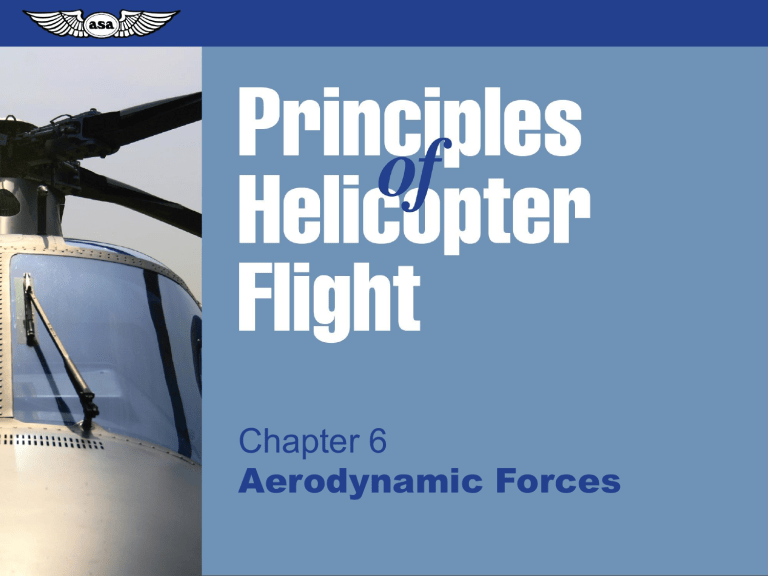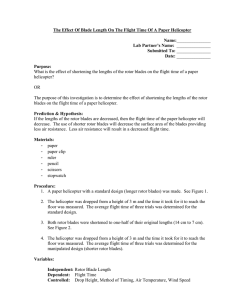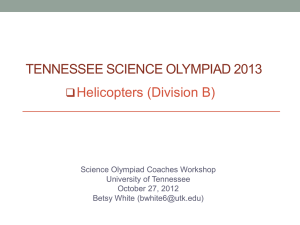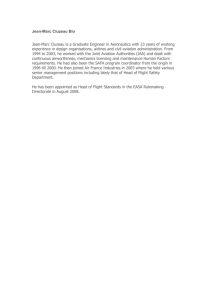PHF Chapter 6 (Powerpoint)

Chapter 6
Aerodynamic Forces
© 2009 Aviation Supplies & Academics, Inc. All Rights Reserved.
Principles of Helicopter Flight
Tip path, tip path plane, shaft axis and plane of rotation. In the situation above, shaft axis and plane of rotation coincide.
Axis of rotation through the rotor head at right angles to the plane of rotation while the shaft axis remains in line with the rotor mast
© 2009 Aviation Supplies & Academics, Inc. All Rights Reserved.
Principles of Helicopter Flight
Coning angle.
© 2009 Aviation Supplies & Academics, Inc. All Rights Reserved.
Principles of Helicopter Flight
Blade angle can be altered by rotating the blade around the feathering axis.
© 2009 Aviation Supplies & Academics, Inc. All Rights Reserved.
Principles of Helicopter Flight
“A” shows a blade’s ability to flap up/down around the flapping hinge.
“B” shows a blade’s ability to move forward or aft around the lead-lag hinge.
© 2009 Aviation Supplies & Academics, Inc. All Rights Reserved.
Principles of Helicopter Flight
Schematic of a fully articulated rotor head. Schematic of a teetering hinge.
© 2009 Aviation Supplies & Academics, Inc. All Rights Reserved.
Principles of Helicopter Flight
Figure 6-1. Vector quantities of airflow experienced by different blade sections. Rotor rpm constant.
© 2009 Aviation Supplies & Academics, Inc. All Rights Reserved.
Principles of Helicopter Flight
Figure 6-2. Vector quantities of airflow experienced by a given blade section at high and low rotor rpm.
© 2009 Aviation Supplies & Academics, Inc. All Rights Reserved.
Principles of Helicopter Flight
Figure 6-3. Blade angle is the angular difference between chord line and the plane of rotation.
In the absence of other airflows, blade angle is also angle of attack.
© 2009 Aviation Supplies & Academics, Inc. All Rights Reserved.
Principles of Helicopter Flight
Figure 6-4. Induced flow entails all air molecules forced down by rotor action; not all of these molecules go through the rotor.
© 2009 Aviation Supplies & Academics, Inc. All Rights Reserved.
Principles of Helicopter Flight
Figure 6-5. Airflow due to rotation (A-B) and induced flow (C-A) combine to produce the relative airflow (C-B). Note the effect of induced flow on angle of attack.
© 2009 Aviation Supplies & Academics, Inc. All Rights Reserved.
Principles of Helicopter Flight
Figure 6-6. Lift at right angles to the relative airflow and drag in line with the relative airflow are components of the total reaction.
© 2009 Aviation Supplies & Academics, Inc. All Rights Reserved.
Principles of Helicopter Flight
Figure 6-7. Total reaction can be split up into two component forces: rotor thrust, acting against the gross weight of the helicopter; and rotor drag (torque), acting against rotation of the blade.
© 2009 Aviation Supplies & Academics, Inc. All Rights Reserved.
Principles of Helicopter Flight
Figure 6-8. In a calm hover (A), total rotor thrust is equal and opposite to the aircraft gross weight.
In forward flight (B), the vertical component of total rotor thrust is equal and opposite to the gross weight.
© 2009 Aviation Supplies & Academics, Inc. All Rights Reserved.
Principles of Helicopter Flight
Figure 6-9. Effect of changes in angle of attack on orientation of the total reaction. Total reaction closer to or further away from the axis of rotation influences the rotor thrust/rotor drag ratio.
© 2009 Aviation Supplies & Academics, Inc. All Rights Reserved.
Principles of Helicopter Flight
Figure 6-10. Effect of difference in induced flow and inflow angle on the rotor thrust/rotor drag ratio. In both diagrams the angle of attack and
Vr are the same. The lift and drag vectors have been omitted for clarity .
© 2009 Aviation Supplies & Academics, Inc. All Rights Reserved.
Principles of Helicopter Flight
Figure 6-11. Diagram showing all the forces acting on the blade and depicting rotor thrust as the force that assists in overcoming the gross weight of the helicopter.
© 2009 Aviation Supplies & Academics, Inc. All Rights Reserved.
Principles of Helicopter Flight
Figure 6-12. Helicopters A and B have precisely the same total rotor thrust but B produces the total rotor thrust at a slightly smaller angle of attack, less lift and less power (and a slightly lower collective setting).
© 2009 Aviation Supplies & Academics, Inc. All Rights Reserved.
Principles of Helicopter Flight
Figure 6-13. Coning angle, governed by the resultant of combined rotor thrust of the blade, and centrifugal force acting through the blade’s centre of gravity.
© 2009 Aviation Supplies & Academics, Inc. All Rights Reserved.
Principles of Helicopter Flight
Figure 6-14. Effect of coning angle on rotor thrust required to provide the opposing force to weight.
© 2009 Aviation Supplies & Academics, Inc. All Rights Reserved.
Principles of Helicopter Flight





